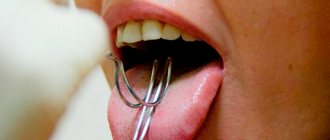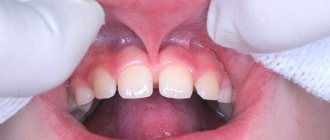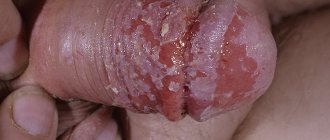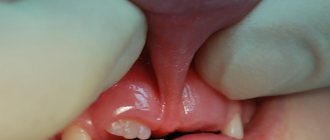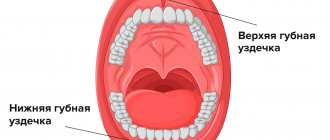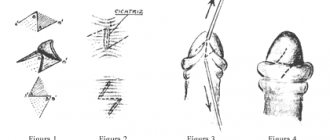Many people have heard about such an operation as cutting the frenulum under the tongue in children, but not everyone understands why and when it is necessary. The problem with the imperfect structure of the hyoid frenulum can appear at different ages
, and parents really need to pay due attention to this. Despite the fact that this part of the body seems very insignificant, it is associated with the process of eating and speech production. Its anomaly can indirectly affect vital phenomena in the body.
The essence of the problem
Photo: this is what a normal frenulum looks like in a child’s mouth
The tongue is attached to the base of the mouth by its root part. Between the tongue and the lower edge of the mouth there is a small fold of skin - the frenulum. Normally, it should be such a length that a person can easily move his tongue, stick it slightly beyond the lips, touch the front surface of the teeth, and pronounce sounds.
A shortened frenulum of the tongue greatly limits its mobility, speech capabilities and ability to eat normally.
, especially in children. The same problems arise if it is not attached correctly, when it is in close proximity to the tip of the tongue.
The consequences are:
- Photo: this is what an incorrectly positioned frenulum looks like
During the period of breastfeeding, the baby is unable to suckle normally, as the tongue is limited in its movements. Because of this, children become very anxious, cry, and lose weight.
- Lack of nutrition can have a negative impact on any developing system of the body, causing stomach diseases.
- A child with a short frenulum develops an incorrect bite, which causes dental diseases and their displacement.
- After teething, when trying to stick out the tip of the tongue, the baby will injure it on the lower incisors.
- In older children, a short hyoid frenulum complicates the formation of sounds: it is difficult for them to pronounce words, and the process of learning speech is delayed.
- The breathing mechanism changes: the baby gets used to breathing through the mouth. Symptoms of the pathology
The frenulum in newborns normally has a length of about 8 mm
or more, and for five-year-old children it increases to 17. But mothers are not always able to take measurements at home, especially if the baby is very active. And only specialists can understand whether everything is located correctly in the oral cavity.
You can determine whether a child has a short frenulum by some external signs:
- In infants, due to their low ability to suck milk, loud smacking and clicking sounds appear.
- The baby attaches incorrectly to the breast, does not cover the areola with his mouth, so he often bites the nipple, which then becomes inflamed.
- The baby is nervous, arches, twists his arms and legs when feeding, often throws and applies to the breast again. Does not gain weight or even lose it.
- The tip of the tongue may be bifurcated due to shortening of the septum. What a child’s forked tongue looks like with a short frenulum, look at the photo on the right.
- Older children have noticeable speech defects, their voice is nasal and quiet.
- Saliva production increases.
- Apnea attacks are possible.
- Due to insufficient food processing, digestive problems occur.
If parents suspect a problem, they should contact their pediatrician or dentist. But in many cases, the defect is determined by a neonatologist in the maternity hospital.
What is it and why do we need it?
Such anatomical formations are the thinnest folds of the mucous membrane that connect the mobile lips and tongue with the fixed parts of the oral cavity: the gums and the sublingual space.
In total, there are three frenulums in the baby’s mouth:
- Tongue - located under the tongue.
- Upper lip - localized between the upper lip and the gum mucosa above the level of the central incisors.
- Lower lip - connects the inner surface of the lower lip with the gums at the level of the middle of the alveolar process on the lower jaw.
Despite their small size, such mucous folds are of great importance in human life. In a newborn, they are responsible for proper attachment to the mother's nipple. In older children, the frenulum is involved in the correct pronunciation of sounds and in the formation of a normal bite.
Causes of the defect
A short frenulum of the tongue in a newborn is a congenital anomaly
, which is formed in the first months of fetal development, when all organs are formed. There are several reasons for its appearance:
- The presence of a hereditary predisposition: if the parents had such a feature, it can be inherited.
- The older the expectant mother, the more likely her child is to develop a short frenulum due to the increased risk of developing anomalies.
- The defect can develop if a woman has an infection during pregnancy or suffers from chronic diseases.
- Severe early toxicosis can lead to a lack of nutrients, which is why the fetal organs do not form correctly.
- Exposure to any teratogenic factors: radiation, toxic substances, drugs that are harmful to the body, alcohol, tobacco and drugs.
- Accidents involving injuries to pregnant women.
Some of these reasons do not depend on the actions of future parents, especially genetic predisposition. Other risk factors should be avoided: a pregnant woman should not work in hazardous work, drink, smoke, self-medicate, or expose herself to the risk of falls when playing sports.
Reasons for the development of tongue frenulum pathology in a child
The formation of an anomaly associated with a short hyoid membrane begins before the birth of the child. This is preceded by negative factors, which include:
- genetic predisposition;
- infection of the fetus during pregnancy;
- viral and infectious diseases suffered by the mother during pregnancy;
- mechanical injuries to the expectant mother’s abdomen;
- the age of the expectant mother is over 35 years;
- unfavorable environmental conditions;
- the influence of other factors of unknown etiology.
Ways to solve the problem
At the moment, there are several correction methods:
- Trimming the frenulum in children with a scalpel.
- Laser cutting of the frenulum under the tongue.
- Stretching through exercise.
- Removing the defect using massage.
Surgical interventions can be performed in different ways, the main methods are:
- Frenuloplasty is the removal of a flap from the tissue of a defective bridge, which is sutured to the resulting wound to increase the mobility of the tongue. Local anesthesia is required, but the damaged mucous membrane heals very quickly. Used for preschool children.
- Frenulotomy: the length of the frenulum is conventionally divided into three parts, an incision is made between the lower and middle lobes, and the edges of the mucous membrane are sutured. This method is suitable for infants.
- Frenulectomy is the same manipulation, but the frenulum is clamped with instruments. The method is suitable for five-year-old children.
In more modern clinics, trimming is performed using a laser. The dissection is carried out after treatment with an anesthetic: gel, spray. For patients, such cutting is less traumatic, damage to blood vessels is minimal - the laser simultaneously cuts the mucous membrane and causes adhesions of the affected capillaries
.
Tissue regeneration after laser trimming takes place within a few days, and you can return to your normal lifestyle an hour after the procedure. But how long you need to stay in the clinic is decided by the doctor. Complications are less common than after eliminating the defect with a scalpel.
Optimal age for surgery
Is it worthwhile to manipulate the frenulum under the tongue and at what age is it better to trim it? Such decisions depend on when the anomaly was discovered and what the individual characteristics are. If in the maternity hospital the neonatologist determines that the baby has a defective hyoid frenulum, it is better to trim it immediately.
The baby is not yet so mobile as to interfere with the procedure, and the membrane itself is small, thin and does not contain blood vessels. Thanks to these factors, local anesthesia will be sufficient for the manipulations, and you can calm the baby by applying it to the chest after the operation.
Trimming the frenulum of the tongue in children over 6 months of age is associated with some difficulties. The baby becomes mobile, and parents cannot discipline him with persuasion. Due to careless movements, surgery may not occur correctly, which is why surgery is postponed until the age of five
.
During this period, children talk, the doctor can determine whether there are speech defects, whether the frenulum under the tongue is bothering the child, whether it needs to be trimmed or whether it can be stretched with gymnastics.
If the infant’s tongue frenulum was not cut, and many years later he developed speech defects, breathing and digestive problems, then it needs to be circumcised in adulthood. But the older a person is, the denser his membrane becomes, it becomes overgrown with capillaries and nerve endings - which is why cutting it is much more painful than in the case of a baby. Anesthesia is required to make the incision.
Who to contact for help
Depending on the complexity of the situation, an orthodontist or speech therapist will help you cope with the problem. In any case, it makes sense to first get a consultation to decide what method of correction the child needs.
The dentist will carefully trim the frenulum, relieving the child of discomfort with one movement of his hand. However, recently doctors still recommend leaving surgical intervention as a last resort. An experienced speech therapist will offer a set of exercises and massage to stretch the frenulum.
Experts say that there are not many situations when the hyoid frenulum is absolutely unable to stretch. In almost all cases, a conservative approach achieves results.
Parents can evaluate the pros and cons of different approaches on their own.
Surgical method:
- A quick, radical solution to the problem.
- The operation is performed using anesthesia.
- The healing process takes some time and is uncomfortable.
- Dietary restrictions due to surgery.
- It is advisable to maintain vocal rest for several days.
- Psychological trauma in the child is possible.
- After the operation, classes with a speech therapist are necessary to correct sound pronunciation.
Frenum stretching method:
- Conservative, does not cause psychological difficulties in the child.
- Effective in most cases.
- Does not require changes to your usual routine.
- It takes some time (several months).
- Requires discipline and regular practice.
In any case, to resolve the issue, you need to consult a speech therapist.
Examinations before surgery and contraindications
Any surgical procedure in the oral cavity is a risk to the body. In order to prevent complications after surgery, it is necessary to undergo preliminary examinations prescribed by the doctor. The most significant tests are blood and urine tests, determination of blood coagulation and fluorography.
Contraindications for frenuloplasty are infections of the throat, oral cavity, inflammatory processes in any part of the body
, since pathogenic microorganisms can enter the incision of the mucous membrane. This is why a mandatory examination is carried out before intervention. You cannot operate on patients with cancer or decreased blood clotting.
Short frenulum and why it is dangerous
Shortening of the frenulum is understood as a decrease in its absolute length or its incorrect location, which makes it relatively short (i.e., the length remains normal, but its incorrect localization causes all the symptoms characteristic of shortening).
A short frenulum of the upper or lower lip in a baby can negatively affect the process of breastfeeding. In this case, the child cannot correctly position the nipple in the oral cavity and create a sufficient vacuum necessary for sucking and swallowing. Therefore, in order to get enough, the baby has to make significant efforts. The baby quickly gets tired and stops breastfeeding without being properly satisfied. Such children behave restlessly, require frequent breastfeeding, but do not gain weight well.
In children over 3 years old, a shortened upper frenulum can cause an increase in the interdental spaces between the upper incisors and their advancement sharply anteriorly. A short lower labial frenulum sometimes causes malocclusion.
Also, a decrease in size or incorrect location of any of them can have an extremely negative impact on speech function. Children 2 years of age who have not had this pathology diagnosed or corrected in time often do not pronounce individual sounds. Such speech defects are difficult to correct.
Postoperative period
The mucous membrane in the mouth is restored quickly. But cutting the frenulum can cause complications:
- Formation of a hard scar at the site where the incision was made.
- The development of the inflammatory process due to infection.
- Temperature increase. It appears as a sign of the development of an infectious process or a peculiar reaction to an operation.
The baby may react to complications with constant anxiety and refusal to eat. Children three years old and older can tell themselves what worries them. If you experience any discomfort, you should consult a doctor; only a specialist will correctly assess the baby’s condition and prescribe the best treatment.
To avoid complications, you need to keep your mouth clean. Five-year-old children already brush their teeth and can rinse their mouths with water. For several days after the defect is removed, you should not chew solid food or talk much.
You should ask your doctor exactly how long the restrictions should be observed. After a follow-up examination, the attending doctor will recommend special exercises to develop the elasticity of the frenulum.
Questions about the article
Peter 20 years old
July 28, 2021 at 00:00
Doctor, hello. We performed a frenuloplasty operation, the operation was bloodless, the doctor did not use a scalpel. On the third day, sex occurred at night. In the morning I noticed very small specks of dried blood on the wound. Please tell me, is this dangerous? Could it be fraught with the formation of a rough scar or any other complications?
drrotov
July 29, 2021 at 15:30
No, I don't think it's dangerous. This area is healing well.
Ivan 21 years old
April 15, 2021 at 00:00
Hello. I had a quadruple operation at once: straightening the inverter (there was a downward tilt), lengthening the frenulum, complete circumcision and ligamentotomy.
drrotov
April 16, 2021 at 12:00
Great! You forgot to ask a question...
Correction using gymnastics for the tongue
Only a doctor can determine whether it is worth performing surgery on a child’s short frenulum of the tongue or whether it is better to remove the defect with the help of exercises. Therefore, even if parents are not inclined to undergo surgery, they still need to go to a pediatrician or dentist for consultation and surgery or correct individual selection of exercises.
The opportunity to conduct gymnastic classes appears when the baby can already repeat some given actions. But there are simple exercises even for newborns: they are given a silver spoon to lick, milk is dripped onto their upper lip, which makes them try to lick it, and at a slightly older age they are smeared with jam.
When the baby is able to understand the mother’s requests to repeat certain actions, you can do more complex gymnastics:
- Close your mouth and feel the side walls of your tongue, palate and lower part of your mouth.
- Open your mouth and reach as far as possible to the outer surface of your lips.
- Click your tongue.
- Place the tongue on your lower lip and hold it in this position for 10 seconds.
- Stick your tongue out as far as possible and hold for 10 seconds. You can also ask the baby in a playful way to show how long his tongue is.
How is a short frenulum of the foreskin diagnosed?
As already mentioned, this defect can only be identified during puberty. That is why adolescents going through this stage need to visit a consultation with a professional urologist.
Diagnosis of the disease involves analyzing the patient’s complaints and conducting an examination of the penis, during which a specialist identifies the existing problem. Timely diagnosis and adequate treatment play a vital role in this case. They eliminate the risk of complications and also prevent psychological trauma to the patient, which can be very difficult to treat.
Torn frenulum
In some children, an unfortunate fall causes a rupture of the frenulum of the tongue. This injury can occur due to close contact of the septum with the lower teeth.
. If a child cuts the frenulum, he may experience bleeding and swelling in the oral cavity, and it becomes painful for the baby to chew and talk.
You cannot rely on self-medication; you should immediately consult a doctor. Sometimes it is necessary to stitch up the resulting wound due to the risk of excessive bleeding.
The importance of such a part of the body as the frenulum cannot be underestimated. There are many ways to lengthen the small septum to free up the tongue for free speech and eating. Before taking certain measures, it is necessary to consult with a specialist and do preoperative tests if it is necessary to trim the frenulum.
If the anomaly causes organ dysfunction, then frenuloplasty is necessary, and it is best to perform it at the age recommended by the doctor. Ignoring such a problem means exposing the child to the risk of frequent respiratory and digestive diseases, and problems in pronunciation of sounds.
Short frenulum: to treat or not to treat?
Hello dear audience, today I, urologist-andrologist Gennady Valentinovich Volovich, would like to consider such a problem as a short frenulum.
Many male representatives believe that this is not a problem at all, many do not notice it in themselves, many believe that it does not need to be treated.
However, relying on my experience and the opinion of my colleagues, I must tell you that a short frenulum can cause many problems
What is a short bridle?
A short frenulum of the penis is a congenital anomaly, manifested in insufficient length of the skin cord between the foreskin and the head of the penis.
Normally, the head of the penis deviates downward relative to the main axis of the shaft of the penis from 0 to 30 degrees. Over 30 degrees is already excessive, and readings of 25-30 degrees can also cause problems under certain circumstances. That is, from 20 to 30 degrees is a relative norm.
Most often, this pathology is detected during the first sexual intercourse, since during an erection the shortened frenulum is subject to excessive tension and rupture. In this case, the injury may be accompanied by severe pain and profuse bleeding, which can lead to significant blood loss, since a large artery passes through the thickness of the frenulum. In less severe forms of this disease, a man may experience:
- strong tension of the frenulum in the erect state of the penis and the development of pain (including during sexual intercourse);
- insufficient filling of the cavities of the cavernous bodies with blood and, as a result, insufficient increase in the volume of the penis and its hardening;
- strong curvature of the penis towards the scrotum, making sexual intercourse very difficult (or even completely inaccessible);
- development of sexual dysfunction, in which ejaculation occurs too quickly; damage to the frenulum during sexual intercourse in the form of cracks and tears with bleeding, which can be very profuse. Bleeding occurs at the most inopportune moment and you have to urgently look for a hospital with improvised bandages
- Due to the incorrect excessive bending of the head of the penis downwards during sexual intercourse, the partner may experience excessive friction in the area of the lower wall of the vagina, vaginal dysbacteriosis occurs, the girl-woman undergoes expensive smears, is treated, but all in vain, since the field of sexual intercourse arises again dysbiosis.
If left untreated, due to frequent tears, the frenulum can turn into a painful scar cord. This entails increased sensitivity of the glans penis, which, in turn, can provoke premature ejaculation. And as a consequence of this, one’s own dissatisfaction and that of one’s partner.
And here's the result:
The development of complications can only be prevented by surgery, and the earlier treatment is started, the fewer old tears in the frenulum, the easier this problem is to correct and the better the postoperative result. The only way to treat this pathology is plastic surgery to lengthen the frenulum - frenuloplasty. It is performed on an outpatient basis under local anesthesia and lasts about twenty minutes. The essence of this surgical intervention is to dissect the short frenulum of the penis in the transverse direction. In some cases, up to three incisions may be required.
The patient can return home on the same day. Wound healing continues for 8-14 days.
In our center, any version of frenuloplasty is performed: using a scalpel, radio knife or laser.
Take care of your health and the health of your partner, check with a urologist for the presence of this pathology, and if there is a problem, have a frenuloplasty.

